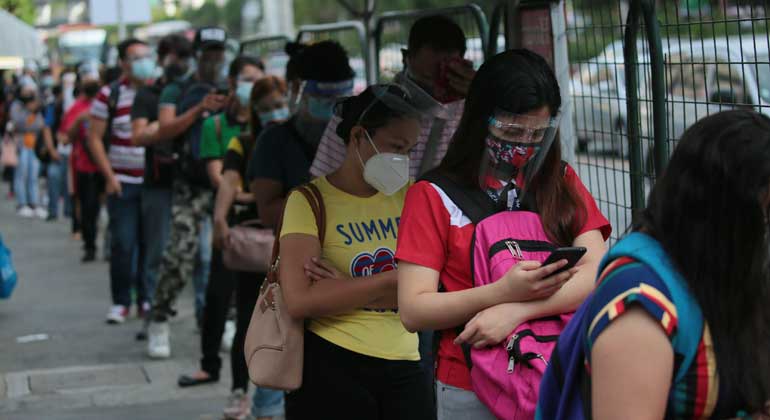
THE Philippine economy is now expected to shrink by 7.3% this year as the pandemic drags on, while “developing Asia” is seen to contract for the first time since 1962, according to the Asian Development Bank (ADB).
In its latest update to the Asian Development Outlook 2020 released Tuesday, the ADB slashed its 2020 gross domestic product (GDP) forecast for the Philippines to -7.3%, much worse than the -3.8% forecast in June and the 2% projection in April.
The estimate is also lower than the -5.5% economic contraction projected by the Philippine government. If the -7.3% forecast is realized, this would be the Philippines’ deepest annual economic slump since 1947, the earliest year with available data.
The Philippine economy is also seen to fare worse than the ADB’s downgraded -3.8% GDP projection for Southeast Asia and -0.7% forecast for developing Asia this year.
The ADB attributed the downgraded GDP forecast for the Philippines to “subdued private consumption and investment expected for the rest of the year and uncertainties about the global economic recovery.”
ADB Country Director for the Philippines Kelly Bird said they expect the country to record a “slow and fragile” recovery for the rest of 2020.
The economy plunged into a recession after a record 16.5% GDP contraction in the second quarter, when lockdowns halted nearly all economic activity.
“We believe the worst is now over and that the contraction in GDP bottomed out in May or June this year. The package of measures the government rolled out such as income support to families, relief for small businesses, and support to agriculture in the second quarter all helped the economy to bottom out,” Mr. Bird was quoted as saying.
For 2021, the ADB maintained its forecast of a 6.5% growth, which matches the low end of the Philippine government’s 6.7-7.5% projection.
The ADB said the country’s expected strong rebound next year hinges on the successful containment of the COVID-19 outbreak, further reopening of the economy and additional stimulus measures from the government.
“Things will improve next year against the assumption that we will be able to contain the outbreak here in the Philippines and you have substantial fiscal and monetary policy support for the economy,” ADB Macroeconomic Research Division Director Abdul Abiad said in an online briefing Tuesday.
Mr. Abiad noted the economy will get a boost next year from the expected rebound in consumption and investments, as well as the improved external environment that will benefit exports, particularly semiconductors.
Downside risks for the economy would be a “slower than expected global recovery that could weigh heavily on trade, investment, and overseas Filipino worker remittances.”
The Philippines is seen to post the second-largest contraction in Southeast Asia, after Thailand’s expected 8% slump while only Vietnam and Brunei are projected to grow.
“With all economies vulnerable to another wave of COVID-19 in the absence of effective vaccines, growth could slow even further if cases continue to soar as they have recently in Indonesia and the Philippines,” the report read.
DEVELOPING ASIA TO SHRINK
“Developing Asia,” which groups 45 countries in Asia-Pacific, is expected to contract 0.7% this year, the ADB said, forecasting the first negative quarterly figure since 1962. The ADB’s previous forecast in June had reckoned on 0.1% growth.
For 2021, the region is forecast to recover and grow 6.8%, still below pre-COVID-19 predictions, the ADB said.
The updated forecasts show the damage brought by the pandemic was greater than previously thought, with about three-quarters of the region’s economies forecast to slump this year.
“Most economies in the Asia and Pacific region can expect difficult growth path for the rest of 2020,” ADB Chief Economist Yasuyuki Sawada said in a statement.
“The economic threat posed by the COVID-19 pandemic remains potent, as extended first waves or recurring outbreaks could prompt further containment measures,” Mr. Sawada said.
While the pandemic remains the biggest downside risk to the region’s outlook, Mr. Sawada said in a separate media briefing “worsening geopolitical tensions” that include the trade and tech war between the US and Beijing, could also dent growth.
China, where the coronavirus surfaced in December, is seen bucking the trend as the ADB kept its 2020 growth forecast at 1.8%. The world’s second-largest economy is expected to rebound strongly to 7.7% in 2021, the ADB said.
India’s economy is expected to contract 9.0% this year, ADB said, a far worse outcome than the 4.0% contraction previously forecast, ADB said. But it also expected India to bounce back with 8.0% growth next year.
Latest forecasts suggest a more protracted “L” shaped recovery for “developing Asia,” Mr. Sawada said.
Depressed demand and lower oil prices allowed the ADB to keep its inflation forecast for developing Asia at 2.9%, and it is predicted to slow further to 2.3% in 2021. — B.M.Laforga and Reuters
